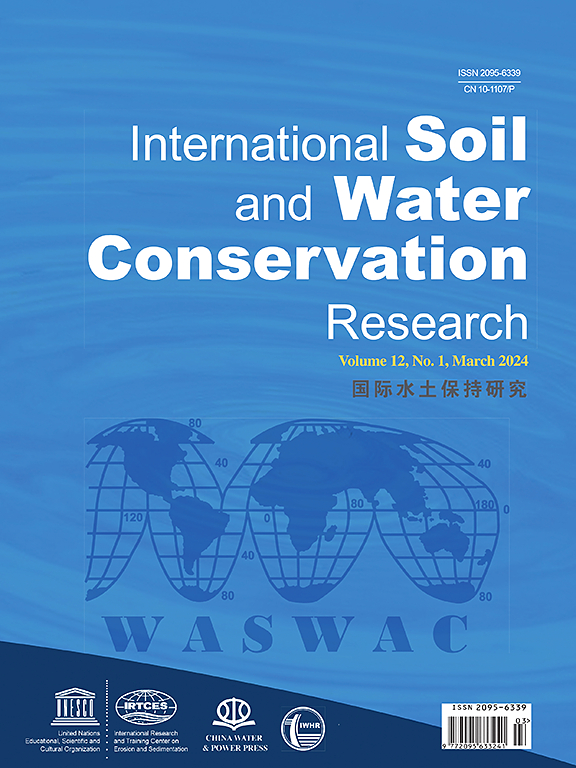2010-2023年密云库区土壤侵蚀和面源污染对不同降雨、植被和整地措施的响应
IF 7.3
1区 农林科学
Q1 ENVIRONMENTAL SCIENCES
International Soil and Water Conservation Research
Pub Date : 2025-07-16
DOI:10.1016/j.iswcr.2025.07.006
引用次数: 0
摘要
土壤侵蚀和非点源污染是严重的全球环境问题,对生态系统、农业生产力和水质有着深远的影响。在遭受强降雨的地区,这些问题尤其加剧,其影响可能特别严重。在中国,北京郊区经历了与土壤侵蚀和非点源污染相关的相当大的挑战。在不同降雨类型下,降雨、植被和整地对土壤侵蚀和非点源污染的影响机制非常复杂,尚未完全了解。本研究基于2010年至2023年16个径流区130次侵蚀性降雨事件(按24小时降水量分为轻、中、强和极端降雨)的土壤侵蚀(径流、产沙量)和非点源污染(TN、总氮、TP、总磷、COD、化学需氧量)数据。径流地块由不同的植被和整地措施组成。比较了4种不同降雨类型和不同水土保持措施下的土壤侵蚀和非点源污染特征。此外,还探讨了不同降雨类型下降雨、植被和整地对土壤侵蚀和面源污染的影响。结果表明,极端降雨事件发生频次仅占侵蚀雨量的16.9%,但其产生的径流、产沙、总氮、总磷和总COD分别占侵蚀雨量的40.7%、35.0%、37.9%、33.4%和41.9%。植被和整地措施对减少径流、产沙量、总氮、总磷和总COD有显著影响。影响径流、全氮、总磷和COD的主要因子是最大30 min降雨强度(I30),相关系数分别为0.33、0.20、0.30和0.28 (p < 0.01)。随着降雨强度的增加,植被对土壤侵蚀和非点源污染的贡献从小雨条件下的0.7%增加到极端降雨条件下的41.1%。在极端降雨条件下,植被和整地的综合效应从1.7%增加到14.4%。在相同降雨条件下,植被和整地对土壤侵蚀的贡献显著高于面源污染。该研究确定了降雨、植被和土地整理在不同降雨条件下影响土壤侵蚀和非点源污染的机制。这些发现为土壤保持和非点源污染管理提供了有价值的见解,特别是在经历极端降雨事件的地区。本文章由计算机程序翻译,如有差异,请以英文原文为准。
Response of soil erosion and non-point source pollution to different rainfall, vegetation and land preparation measures in Miyun reservoir area during 2010–2023
Soil erosion and non-point source pollution are critical global environmental issues, with profound implications for ecosystems, agricultural productivity, and water quality. These problems are especially exacerbated in regions subjected to intense rainfall, where their impacts can be particularly severe. In China, the suburban areas of Beijing have experienced considerable challenges associated with both soil erosion and non-point source pollution. Under different rainfall types, the impact mechanisms of rainfall, vegetation, and land preparation on soil erosion and non-point source pollution are highly complex and have not yet been fully understood. This study is based on soil erosion (runoff, sediment yield) and non-point source pollution (TN, Total nitrogen; TP, Total phosphorus; COD, Chemical Oxygen Demand) data from 130 erosive rainfall events (Classified as light, moderate, heavy and extreme rainfall based on 24-h precipitation) across 16 runoff plots from 2010 to 2023. The runoff plots consist of different vegetation and land preparation measures. The characteristics of soil erosion and non-point source pollution under four different rainfall types and different soil conservation measures were compared. Additionally, the impacts of rainfall, vegetation, and land preparation on soil erosion and non-point source pollution under different rainfall types were explored. The results indicate that the frequency of extreme rainfall events accounts for only 16.9 % of erosive rainfall, yet the runoff, sediment yield, TN, TP, and COD they generate account for 40.7 %, 35.0 %, 37.9 %, 33.4 %, and 41.9 % of the total, respectively. Vegetation and land preparation measures have a significant effect on reducing runoff, sediment yield, TN, TP, and COD. The primary factor influencing runoff, TN, TP, and COD was maximum 30-min rainfall intensity (I30), with correlation coefficients of 0.33, 0.20, 0.30, and 0.28, respectively (p < 0.01). As rainfall intensity increases, the contribution of vegetation to soil erosion and non-point source pollution increases from 0.7 % under light rainfall to 41.1 % under extreme rainfall. The combined effect of vegetation and land preparation increases from 1.7 % to 14.4 % under extreme rainfall. Under the same rainfall conditions, the contribution of vegetation and land preparation to soil erosion is significantly higher than that to non-point source pollution. The study identifies the mechanisms by which rainfall, vegetation, and land preparation influence soil erosion and non-point source pollution under varying rainfall conditions. These findings offer valuable insights for soil conservation and non-point source pollution management, particularly in areas experiencing extreme rainfall events.
求助全文
通过发布文献求助,成功后即可免费获取论文全文。
去求助
来源期刊

International Soil and Water Conservation Research
Agricultural and Biological Sciences-Agronomy and Crop Science
CiteScore
12.00
自引率
3.10%
发文量
171
审稿时长
49 days
期刊介绍:
The International Soil and Water Conservation Research (ISWCR), the official journal of World Association of Soil and Water Conservation (WASWAC) http://www.waswac.org, is a multidisciplinary journal of soil and water conservation research, practice, policy, and perspectives. It aims to disseminate new knowledge and promote the practice of soil and water conservation.
The scope of International Soil and Water Conservation Research includes research, strategies, and technologies for prediction, prevention, and protection of soil and water resources. It deals with identification, characterization, and modeling; dynamic monitoring and evaluation; assessment and management of conservation practice and creation and implementation of quality standards.
Examples of appropriate topical areas include (but are not limited to):
• Conservation models, tools, and technologies
• Conservation agricultural
• Soil health resources, indicators, assessment, and management
• Land degradation
• Sustainable development
• Soil erosion and its control
• Soil erosion processes
• Water resources assessment and management
• Watershed management
• Soil erosion models
• Literature review on topics related soil and water conservation research
 求助内容:
求助内容: 应助结果提醒方式:
应助结果提醒方式:


